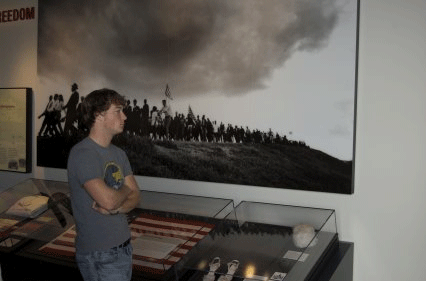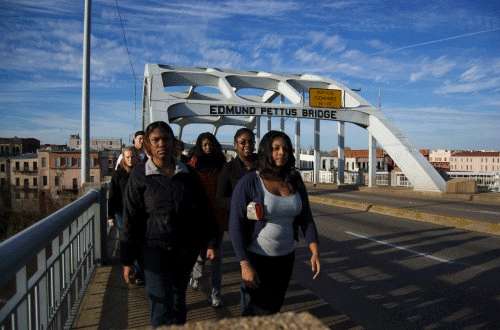We packed up in Montgomery this morning and headed up to Selma, along the same route that the Selma to Montgomery Voting Rights March took in 1965. The highway is peppered with historic markers commemorating the march and the individuals who supported it.We stopped at the Lowndes County Interpretive Center and met our guide for the day, Ms. Joann Blackmon Bland, the former director of the National Voting Rights Museum and a participant in the Bloody Sunday march over the Edmund Pettus Bridge. The Interpretive Center covered the history of the area in the 1950’s. Ms. Bland brought to our attention that the site was a tent city rarely mentioned in the history books. After  black sharecroppers marched and registered to vote in 1955, white landowners evicted them from the land they had farmed for generations. These people had nowhere to go and were put up in tent cities for 2½ years until desegregation supporters were able to help them find homes.
black sharecroppers marched and registered to vote in 1955, white landowners evicted them from the land they had farmed for generations. These people had nowhere to go and were put up in tent cities for 2½ years until desegregation supporters were able to help them find homes.
 In Selma, we toured the town and stopped at the Brown A.M.E. Chapel where the march departed from. Ms. Bland took us around the back of the church to the very ground that marked the starting point. She had each of us pick up a pebble, and told us stories of the individuals who had stood on those pebbles on the day of the march.
In Selma, we toured the town and stopped at the Brown A.M.E. Chapel where the march departed from. Ms. Bland took us around the back of the church to the very ground that marked the starting point. She had each of us pick up a pebble, and told us stories of the individuals who had stood on those pebbles on the day of the march.
Finally, the marchers were beaten back to the First Baptist church on Bloody Sunday. We stood on the steps as she described the violence that took place that night.
Lunch at Essie’s Place was a hit, not only because the food was delicious, but also because we were got to meet two other people who were part of the history of the area. First, Ms. Bland’s sister, Lynda Blackmon Lowery, who was beaten on Bloody Sunday, and went on to march the entire way from Selma to Montgomery two weeks later in order to show the governor what he had done to her. The second was a gentleman who happened to be in the restaurant, Mr. Dudley, who had lived in the area his whole life, and been active in voter registration. In 2000, after 16 years on the police force with a perfect conduct record, he ran afoul of the whites in power and was arrested on a false charge of voter registration fraud. He was sent to jail for two years. He spoke about how powerless he felt then, as he had the times when his aunt was “taken advantage of” by whites when he was a child. He told us that he used to hate white people, but through religion, had let go of that hate.
After lunch, Ms. Bland took us to the foot of the Edmund Pettus Bridge and spoke to us about the need to commit to making the world a better place for our children. We crossed the bridge stopping to visualize the events that had taken place there. We spent a long time soaking up the presence of the place before visiting the new National Voting Rights Museum, which is still in the process of moving.
Our dinner discussion lasted late into the night as we talked about what we had seen and how we felt about it.
Student Responses:
Sarayfah: Joanne Bland was one of the most extraordinary persons that I have met so far on this trip. I was really honored to be in her presence as she was one of the many foot soldiers of the Civil Rights Movement. Joanne was selfless in her wish to make life better for future generations – to help them succeed and have equal access to the basic right of voting. We were able to carry with us a piece of the playground on which Joanne and other participants walked on their way to march across the Edmund Pettus Bridge. These are some of the priceless experiences that a person can have when they realize that the history and the struggle that took place in Selma only 40 years ago has not died and the fight persists.
Joanne has taken it upon herself to reach out the youth in her area as she knows all too well the vicious cycle that these youth fall into as a result of the breakdown in communal structure. It is clear that the black community is not as strong as it used to be and that the black community has lost cohesion when a small amount of progress has been achieved. However, I think that Joanne was making clear that the battle is not over yet and that we are the generation to affect those changes. Those men, women, and children who marched for freedom and equality have laid the ground work for my generation to dream that anything is possible. But, that dream will not be fulfilled and the opportunities that youth have will not be fully understood and appreciated until history is portrayed accurately. People like Joanne should be recognized for their bravery and I am making a commitment and pledge to make her dream a reality through my life’s work. She is my hero!
Amanda: Our two days in Montgomery also included Selma. We learned that the two places go hand in hand when thinking about the Civil Rights Movement due to the march from Montgomery to Selma over the Edmund Pettus Bridge. Joanne Bland, a native from Selma who participated in the march, led us through Selma starting in its projects. These projects were where the black churches resided within the town, the black churches in which the march was planned and where it began.
As emotional as walking on the bridge was, walking through the projects was the part of the day that affected me most. Joanne, who is practically a celebrity in Selma due to her participation in the movement, is forced to see the movement’s failures almost every day through the continuous poverty. Young people stand on the corners, possibly selling drugs or participating in gang violence when they should be in school receiving some kind of education. Though the education in these places might only give them a fourth grade reading level at the most. They are stuck in this poverty. As C.T. Vivian, Charles Person, and Carolyn McKinley preached, it is the youth of America that has to continue the movement, and education is the key.
Peter: Selma. That was our day today. Probably the most powerful day that we have experienced on this trip thus far. The day was awesome! We had a wonderful tour of the area from Joann Bland and we drove over the Edmund Pettus Bridge. We ate some awesome Southern food, and we got to speak to some great individuals like a man we will only know as “Mr. Dudley” who was arrested and spent two years for what seemed to be an unlawful conviction on chargers of voter fraud. We listened to Southerners our parents’ age talk about race relations in the 60’s and now, and it was fascinating to hear their first hand accounts of life and living in the deep American South. However, after we spoke to these people we were able to walk across the Edmund Pettus Bridge. The same way the protesters did led by John Lewis and Hosea Williams in March of 1965. We traced their same steps towards freedom and equality 44 years later.
Walking across the bridge was something else. I’ve seen the video of John Lewis and countless others taking the courageous steps towards the police on the other side of the bridge on video more times than I can recall, but actually taking the same steps was a whole other experience. My initial reaction was when we first crossed the bridge; we couldn’t see the other side because of the arc of the bridges architecture. It’s not until you get to the middle of the bridge that you can see the other side. My initial response was wow; there were armed police on the other side of the bridge waiting with billy clubs, tear gas, horses, and hate on the other side of the bridge waiting for these unarmed civil rights demonstrators. The protestors couldn’t see this, although they knew they were there, and they marched anyway. They marched because they had sight into the future, they marched because they wanted to, and they marched because they had to. There was no other option; living in an oppressive was not an alternative.
Bloody Sunday was just that. People were tracked down and beaten by the authorities; men, women, children, were injured for the cause. The bridge was a symbol, the bridge was a symbol of moving from the past to the future and I was privileged enough to be afforded the opportunity to make this physical connection to history. I doubt I will ever forget what it was like to walk across this bridge for the rest of my days. Words really can’t describe the power that this bridge and this history hold.




